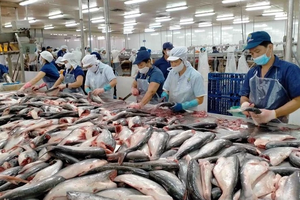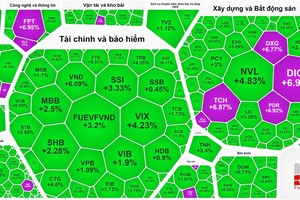
Interest rates decline further
From mid-November this year, most commercial banks simultaneously lowered their deposit rates further, although they had adjusted deposit interest rates many times before. The interest rates for over 12 month-term deposits of many banks have dropped to less than 6 percent per annum. Meanwhile, the interest rates for less-than-six-month terms in some commercial banks have also lowered to around 3 percent per annum, much lower than the ceiling regulated by the State Bank of Vietnam (SBV). The reduction of deposit interest rates has further facilitated commercial banks to offer several preferential interest rate packages for enterprises during the business occasion at the end of the year.
For instance, the lending interest rate of business loans for small and medium-sized enterprises applied by Vietcombank is at only 5.9 percent per annum, lower than the 12-month deposit interest rate of some other commercial banks in the market. Agribank has also continued to reduce lending interest rates by 0.3 percent for five priority areas, of which lending interest rate for short-term loans is only at the maximum of 4.5 percent per annum.
Joint-stock commercial banks also have many preferential loan packages to stimulate the demand for loans to embark on the business season at year’s end of individual customers and business households. Specifically, from now to the end of December 2020, VPBank has a credit package to support customers, who are individuals, groups of individuals, and households, taking loans for production and business with interest rates from only 5.99 percent per annum and a loan limit of up to VND20 billion per customer with many forms of mortgage.
Similarly, HDBank also has a VND5-trillion credit package for customers with the demand to supplement capital and meeting standard credit conditions for small and medium-sized businesses with interest rates from 6.2 percent per annum. VietCapital Bank applies a preferential loan package of VND3.5 trillion for individuals with interest rates from 7.99 percent per annum. ABbank also has a program of refinancing investment for small and medium-sized enterprises until June 2021 with medium and long-term interest rates from only 8.5 percent per annum.
According to experts, the current lending interest rates have decreased by 2.5 percent compared to 2016 and are at the lowest levels in history. However, to support credit growth during the last months of the year, interest rates will be kept at low levels in the coming months because the economy's capability of absorbing capital remains modest. Moreover, the SBV still emphasizes lowering interest rates to have enough resources to support the economy. According to Dr. Tran Du Lich, from the beginning of the year until now, the SBV has reduced the operating interest rate three times with a total reduction of 1.5-2 percent per annum, thereby creating a cheaper source of capital for commercial banks. To stimulate economic growth, interest rates need to decrease further, because, with the inflation level of about 4 percent this year, the current lending interest rates have not been low yet.
Credit will reach about 10 percent in 2020
By the end of October, the credit growth of the banking system was about 6.15 percent compared to the end of last year. In October alone, credit growth increased by more than one percentage point, much faster compared to the previous months. This shows that the recovery speed of enterprises and the economy is relatively good.
According to Mr. Dao Minh Tu, Deputy Governor of the SBV, under the conditions that the Covid-19 pandemic is controlled well as currently, and enterprises recover strongly, credit growth may reach 8-10 percent this year. Not only taking advantage of the season to boost credit to the market, but commercial banks are also continuing to restructure debts, reduce lending interest rates for customers affected by the pandemic, natural disasters, and floods. Specifically, from November 11, commercial banks have decided to cut interest rates by up to 1 percent per annum for all existing loans and new loans of enterprises and people in the Central provinces.
Similarly, besides the VND20 trillion support package for enterprises during the period of social distancing last April, Techcombank continued to launch an additional credit support package of VND18 trillion phase two, with preferential interest rates only from 6.3 percent per annum in September when the Covid-19 pandemic recurred. And the support package has been almost disbursed. Along with that, banks have also promoted retail credit, including home loans and car loans. Many banks offer car loan packages with interest rates from 7-9 percent per annum. Interest rates for home loans are also considered as the lowest levels in the past ten years, at 7-11.5 percent per annum in the first 1-3 years.
In fact, many commercial banks have used up the credit room assigned at the beginning of the year and are loosened credit room. For instance, Techcombank and VPBank have increased credit limits to 19-23 percent in 2020. The credit room of MBB is also adjusted from 11.75 percent to 20 percent. Sacombank is loosened its credit room to 14 percent.
The fact that commercial banks ask to loosen credit room to prepare well the capital sources for the year-end credit demand is expected to increase sharply. The latest survey of the Monetary Forecasting and Statistic Department under the SBV shows that more than 50 percent of credit institutions expect customers' loan demand to increase again and reach 4.7 percent in the fourth quarter of this year. The survey results also show that 49 percent of credit institutions expect that in the last months of this year, import and export will be the driving force of credit growth, followed by wholesale and retail with 47 percent, garment and textile with 41 percent, and construction with 40 percent. These are also the four fields forecasted by most credit institutions to be the driving force for credit growth in 2021.
From mid-November this year, most commercial banks simultaneously lowered their deposit rates further, although they had adjusted deposit interest rates many times before. The interest rates for over 12 month-term deposits of many banks have dropped to less than 6 percent per annum. Meanwhile, the interest rates for less-than-six-month terms in some commercial banks have also lowered to around 3 percent per annum, much lower than the ceiling regulated by the State Bank of Vietnam (SBV). The reduction of deposit interest rates has further facilitated commercial banks to offer several preferential interest rate packages for enterprises during the business occasion at the end of the year.
For instance, the lending interest rate of business loans for small and medium-sized enterprises applied by Vietcombank is at only 5.9 percent per annum, lower than the 12-month deposit interest rate of some other commercial banks in the market. Agribank has also continued to reduce lending interest rates by 0.3 percent for five priority areas, of which lending interest rate for short-term loans is only at the maximum of 4.5 percent per annum.
Joint-stock commercial banks also have many preferential loan packages to stimulate the demand for loans to embark on the business season at year’s end of individual customers and business households. Specifically, from now to the end of December 2020, VPBank has a credit package to support customers, who are individuals, groups of individuals, and households, taking loans for production and business with interest rates from only 5.99 percent per annum and a loan limit of up to VND20 billion per customer with many forms of mortgage.
Similarly, HDBank also has a VND5-trillion credit package for customers with the demand to supplement capital and meeting standard credit conditions for small and medium-sized businesses with interest rates from 6.2 percent per annum. VietCapital Bank applies a preferential loan package of VND3.5 trillion for individuals with interest rates from 7.99 percent per annum. ABbank also has a program of refinancing investment for small and medium-sized enterprises until June 2021 with medium and long-term interest rates from only 8.5 percent per annum.
According to experts, the current lending interest rates have decreased by 2.5 percent compared to 2016 and are at the lowest levels in history. However, to support credit growth during the last months of the year, interest rates will be kept at low levels in the coming months because the economy's capability of absorbing capital remains modest. Moreover, the SBV still emphasizes lowering interest rates to have enough resources to support the economy. According to Dr. Tran Du Lich, from the beginning of the year until now, the SBV has reduced the operating interest rate three times with a total reduction of 1.5-2 percent per annum, thereby creating a cheaper source of capital for commercial banks. To stimulate economic growth, interest rates need to decrease further, because, with the inflation level of about 4 percent this year, the current lending interest rates have not been low yet.
Credit will reach about 10 percent in 2020
By the end of October, the credit growth of the banking system was about 6.15 percent compared to the end of last year. In October alone, credit growth increased by more than one percentage point, much faster compared to the previous months. This shows that the recovery speed of enterprises and the economy is relatively good.
According to Mr. Dao Minh Tu, Deputy Governor of the SBV, under the conditions that the Covid-19 pandemic is controlled well as currently, and enterprises recover strongly, credit growth may reach 8-10 percent this year. Not only taking advantage of the season to boost credit to the market, but commercial banks are also continuing to restructure debts, reduce lending interest rates for customers affected by the pandemic, natural disasters, and floods. Specifically, from November 11, commercial banks have decided to cut interest rates by up to 1 percent per annum for all existing loans and new loans of enterprises and people in the Central provinces.
Similarly, besides the VND20 trillion support package for enterprises during the period of social distancing last April, Techcombank continued to launch an additional credit support package of VND18 trillion phase two, with preferential interest rates only from 6.3 percent per annum in September when the Covid-19 pandemic recurred. And the support package has been almost disbursed. Along with that, banks have also promoted retail credit, including home loans and car loans. Many banks offer car loan packages with interest rates from 7-9 percent per annum. Interest rates for home loans are also considered as the lowest levels in the past ten years, at 7-11.5 percent per annum in the first 1-3 years.
In fact, many commercial banks have used up the credit room assigned at the beginning of the year and are loosened credit room. For instance, Techcombank and VPBank have increased credit limits to 19-23 percent in 2020. The credit room of MBB is also adjusted from 11.75 percent to 20 percent. Sacombank is loosened its credit room to 14 percent.
The fact that commercial banks ask to loosen credit room to prepare well the capital sources for the year-end credit demand is expected to increase sharply. The latest survey of the Monetary Forecasting and Statistic Department under the SBV shows that more than 50 percent of credit institutions expect customers' loan demand to increase again and reach 4.7 percent in the fourth quarter of this year. The survey results also show that 49 percent of credit institutions expect that in the last months of this year, import and export will be the driving force of credit growth, followed by wholesale and retail with 47 percent, garment and textile with 41 percent, and construction with 40 percent. These are also the four fields forecasted by most credit institutions to be the driving force for credit growth in 2021.
























